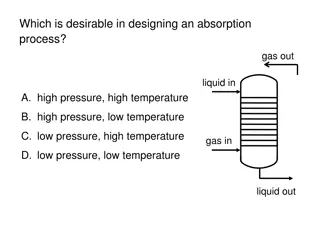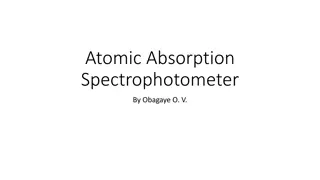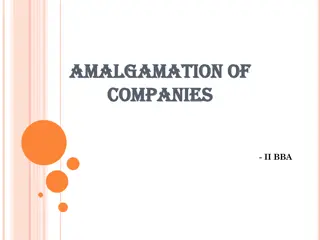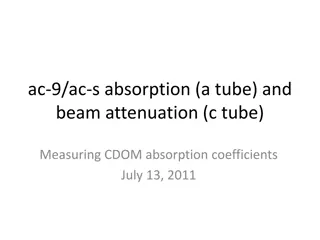Amalgamation and Absorption
Amalgamation in company law refers to the process where two or more companies merge to form a new entity, with specific accounting standards to be followed. There are two types of amalgamation - in the nature of a merger or a purchase. In a merger, assets and liabilities are transferred seamlessly, while in a purchase, one company acquires another without merging operations. These distinctions are crucial for shareholders and stakeholders involved in the process.
Download Presentation

Please find below an Image/Link to download the presentation.
The content on the website is provided AS IS for your information and personal use only. It may not be sold, licensed, or shared on other websites without obtaining consent from the author.If you encounter any issues during the download, it is possible that the publisher has removed the file from their server.
You are allowed to download the files provided on this website for personal or commercial use, subject to the condition that they are used lawfully. All files are the property of their respective owners.
The content on the website is provided AS IS for your information and personal use only. It may not be sold, licensed, or shared on other websites without obtaining consent from the author.
E N D
Presentation Transcript
Amalgamation & Absorption Prepared by: Mohd. Rehan Assistant Professor ARSD College
Meaning of Amalgamation When two or more existing companies go into liquidation and a new company is formed to take over their business ,it is known as amalgamation. The institute of chartered accountants of India has issued Accounting Standard 14 (AS 14) on accounting for amalgamation.This standard specifies the procedure of accounting for amalgamation and the treatment of any resultant goodwill or reserve.
Types of Amalgamation From Accounting point of view : A. Amalgamation in the nature of merger. B. Amalgamation in nature of purchase.
Amalgamation in the nature of Merger An amalgamation should be considered in nature of merger if it fulfills following conditions : All assets & Liabilities of the transferor company become the assets & liabilities of transferee co. after amalgamation. Shareholders holding not less than 90% of face value of equity share capital of the transferor company (other than equity shares already held therein, immediately before the amalgamation, by the transferee company or its subsidiaries or their nominees) become the equity shareholders of the transferee by virtue of the amalgamation. The business of transferor company is intended to be carried on, after the amalgamation by the transferee company. 1. 2. 3.
4.The consideration for amalgamation receivable by those equity shareholders of the transferor company who agree to become equity shareholders of the transferee company is discharged by the transferee company wholly by issue of equity shares in the company, except that cash may be paid in respect of any fractional shares. 5.No adjustment is intended to be made to the book values of the assets and liabilities of the transferor company when they are incorporated in the financial statements of the transferee company except to ensure uniformity of accounting policies. In this way there is a pooling of assets and liabilities of the combining companies under amalgamation. It must be ensured that the resultant figures of the assets, liabilities, capital and reserve of the combining entity more or less represent the addition of the relevant figures of the amalgamation entities.
Amalgamation in the nature of Purchase An amalgamation in nature of purchase takes place when any one or more of the conditions specified for the amalgamation merger is not satisfied. Under this nature of amalgamation one company acquires another company shareholders of the combining entities do not continue to have proportionate share in the equity of the combined entity or the business of the combined entity is not intended to be combined after amalgamation. in nature of and equity
Absorption When one or more existing companies go into liquidation and some existing company buys the business, it is known as absorption. The major characteristics of the absorption are as follows : 1.There is no formation of any new company. 2.There is an absorption of one or more existing companies by one existing company. 3.There is only liquidation of absorbed company while the absorbing company retains its legal entity.
External Reconstruction External reconstruction is effected by liquidating the company.It is just like by absorption. In it a new company is formed to purchase the business of an existing company. The assets and liabilities of the existing company are transferred to the newly formed company. X ltd goes into liquidation and a new company Y ltd comes into existence to take over the business of X ltd, this is the case of the External Reconstruction.
Difference between Amalgamation, Absorption & Reconstruction Basis No of Distinction 1.Formation of a New Company. formed in a Amalgamation. Amalgamation Absorption Reconstruction New company is No new company is formed absorption. New company is formed External Reconstruction. One company is required to wind up its business. in in 2.No Companies Liquidating At companies up their business. least two wind At company required to wind up its business. least one is 3.Objective The aim of the amalgamation to remove competition among entities. Generally weaker units are over by units The aim of the external reconstruction is to write off the accumulated losses fictitious assets. is taken strong the the and
Differences Basis Distinction 4.Position companies No of Amalgamation Absorption Reconstruction of The position of the companies is almost same. The position of purchasing company comparatively better vendor company. The position of vendor is bad because of accumulated losses fictitious assets. company is than and
Purchase Consideration Purchase Consideration refers to the amount paid by the purchasing company to the vendor company for the purchase of business. The purchase consideration for amalgamation includes the shares and other securities issued and payment made in cash or other assets by the transferee company to the shareholders of transferor company. It should not include the amount of liabilities taken over by transferee company, which will be paid directly by this company. Payments made to debenture holders should not be considered as part of purchase consideration.
Methods of Purchase Consideration 1. Lump sum Method 2. On basis of Value of Shares or Shares Exchange Method 3. Net Payment Method. 4. Net Worth or Net Assets Method.
Lump sum Method Under this method,purchased consideration is specified at a particular figure and goodwill or capital reserve is arrived at on the basis of this figure. For example,a Company ABC ltd purchase the business of the company XYZ ltd at an agreed price of Rs.10,00,000 in all. Here the amount of Rs. 10,00,000 is the purchase consideration.
On basis of Value of Shares or Shares Exchange Method Under this method,the purchase consideration is required to be calculated on the basis of intrinsic value of shares. Intrinsic value is calculated by dividing the net assets available for equity shareholders by the number of equity shares. This value determines the ratio of exchange of the shares between transferor companies. the transferee and Intrinsic value of share = Net assets available for Equity Shareholders Number of equity shares
E.g.Suppose A ltd and B ltd are two companies involved in same business. Their capital is Rs. 6,00,000 and Rs. 2,00,000 (each of Rs.10).The two companies arrived to amalgamate in AB ltd. If each share of A ltd and B ltd is valued at Rs. 10 and Rs. 20 respectively for the purpose of amalagmation, the purchase consideration will be as under : A ltd 60000 shares@Rs.10 600000 20000 shares@Rs.20 - B ltd - 400000 Note: While issuing shares to individual shareholders of the selling company, these may be in fractions. A company cannot issue shares in fraction but it can issue fractional certificates or coupons or pay cash for the fractions.
3.Net Payment Method. Under this method the purchase consideration is arrived at by merely adding every component of purchase consideration in respect of which the purchasing company makes payment. The following Points should be considered at the time of calculation of purchase consideration: 1.The assets & liabilities taken over by the transferee co.are not to be considered. 2. Any payment whether in cash or shares made by the transferee co. for shareholders must be considered. 3. If creditors and debtors are taken over by transferee co. to discharge subsequently such amount should not be considered in purchase consideration. 4. If the liquidation expenses of the transfer co. are to be born by transfer co., these should not consideration. 5. Any payments made by the transferee co. to some other party on behalf of the transferor co.are to be ignored. 6. When liabilities are taken over by transferee co. they are neither added or deducted to the amount of purchase consideration. be increased in purchase
4.Net Worth or Net Assets Method. Under difference between the value of the assets taken over and the liabilities assumed. Net asset or Net worth = Assets taken over Liabilities assumed (at agreed value) this method, purchase consideration is the (at agreed value)
Important points to be considered : Assets taken over by purchasing Co. should be valued at agreed price. All assets means not just the tangible assets e.g. cash and bank but the intangible assets e.g. goodwill, trademarks etc. all taken at agreed value. The liabilities assumed by purchasing company are deducted at their agreed value. The term liabilities does not include undistributed profits like reserve fund ,general fund, share premium,insurance fund. The consideration for the amalgamation should include any non-cash element at fair value. In case of issue of securities, the value fixed by the statutory authorities may be taken to be their fair value. Where the scheme of amalgamation provide for an adjustment to the consideration contingent on one or more future events, the amount of additional payment should be included in the consideration if payment is probable and a reasonable estimate of the amount can be made.
The following entries should be passed in the books of transferor and transferee companies in the case of amalgamation In books of Transferor co. 1. For transferring assets taken over by the transferee company. Realisation a/c To Various assets (individually)(at book value) Note : Assets on which some provisions has been made are to be transferred to realisation account at their gross figures and provisions made should be transferred along with liabilities. Dr. 2. For transferring liabilities taken over by the transferee company. Various liabilities a/c To Realisation a/c Note: Only those liabilities are to be transferred which have been assumed by the transferee co. If there is any fund which partially represents liability and partially represents undistributed profit, then that portion which represents liability should be transferred to realisation a/c. Dr. (at book value)
3. For Purchase consideration Transferee Company s a/c To Realisation a/c 4. For receiving PC from the transferee Co. Bank a/c Shares in transferee Co. a/c To Transferee Co a/c 5.For assets sold bt the transferor co. not taken over by the transferee co. Bank a/c Realisation a/c (if loss on sale of assets)Dr. To Assets a/c To Realisation a/c (if profit on sale of assets) Dr. Dr. Dr. Dr.
6.For Liquidation Expenses (a) If expenses are to be met by transferor co. Realisation a/c To Bank a/c (b)If Expenses are to be met by transferee co. there are two alternatives : First alternative : No entry Second alternative : (i) Transferee Co. a/c To Bank a/c (ii) Bank a/c To Transferee co. s a/c 7. For liabilities not taken over by the transferee co. when paid by the transferor co. Various liabilities a/c Realisation a/c (if excess payment is made) To Bank a/c or To Shares in transferee Co. a/c To realisation a/c (if less payment is made) Dr. Dr. Dr. Dr.
8. For transferring preference share capital Preference share capital a/c ..Dr. Realisation a/c(if excess is to paid) ..Dr. To Preference Shareholders a/c To Realisation a/c (if less is to be paid) 9. Preference Share Holders ..Dr. To equity/Preference Shares of transferee co. Note : If the arrears of the dividend are to be paid to preference Shareholders, then such excess amount should be debited to realisation a/c and credited to preference shareholders a/c. If the preference shareholders have agreed to get less than the amount of capital, then reverse entry is to be passed.
10. For closing Realisation a/c (a) If profit Realisation a/c ..Dr. To equity Shareholders a/c If Loss (b) Equity shareholders a/c To Realisation a/c ..Dr 11. For transferring equity share capital and accumulated profit Equity Share Capital a/c General reserve a/c Debenture Redemption Fund a/c Dividend equilisation Reserve a/c Securities Premium a/c Profit & Loss a/c Accident Compensation Fund a/c (to the extent it does not denote the liability) Shares Forfeited a/c Profit Prior to incorporation a/c Any other reserve or Fund a/c To Equity shareholders a/c ..Dr. ..Dr. ..Dr. ..Dr. ..Dr. ..Dr. ..Dr. ..Dr. ..Dr. ..Dr
12. For transferring accumulated losses and expenses not writtenoff Equity shareholders a/c To Profit & Loss a/c ( Debit balance) To Discount or exp on issue of shares or debentures a/c To Preliminary Expenses To Underwriting commission ..Dr. 13. For paying Shareholders Equity Shareholders a/c To Bank or Shares in Transferee co. a/c ..Dr.
Accounting entries in books of transferee Co. There are two methods of accounting for amalgamation in the books of transferee company : 1.The pooling of Interest Method 2.The purchase Method
Pooling of Interest method The following journal entries are to be passed in books of transferee co.for incorporating the financial statements of the transferor co: (1) On amalgamation of business Business Purchase a/c To Liquidators of Transferee Co. a/c (2) For recording assets & liabilities taken over Sundry assets(individually) To Sundry Liabilities(individually) (Book Value) To Reserves a/c (Book Value) To Business Purchase a/c (Book Value) ..Dr.(with amt of PC) (Book Value) Note :The difference between debits & credits is adjusted in the reserves of transferee company.
Instead Of passing Two entries, one combined entry can be passed. Sundry assets a/c To Sundry Liabilities To Different reserves of transferee co To Liquidators of transferor Co. ..Dr (3) For making payment to the liquidator of transferor co. Liquidators of transferor Co. a/c To Bank/Share Capital/Security Premium Dr. (4) If Liquidation expenses are paid by the transferee company. General reserve or Profit & Loss a/c To Bank a/c Dr. (5) For formation expenses of the transferee co. Preliminary Expenses a/c To Bank a/c Dr.
Purchase Method The following Journal entries are passed in the books of transferee company for incorporation of the financial statements of the transferor co. (1) For purchase of business from the transferor company : Business Purchase a/c ..Dr. (For PC) To Liquidation of transferor co. (2) For recording assets & liabilities taken over Various assets a/c ..Dr. (at revised value, if any otherwise To various Liabilities a/c (with figures at which taken over) To Business Purchase a/c Note : If credit is more than debit it is debited to Goodwill a/c but if the debit is more than credit then it is credited to capital reserve a/c. at book value) they are
(3) For making payment to the liquidator of the vendor company : Liquidators of transferor co. a/c To Bank a/c To Share Capital a/c ..Dr (4) When Statutory Reserve is maintained Amalgamation adjustment a/c To Statutory Reserve a/c ..Dr (5) If liquidation exp are paid by transferee co. Goodwill a/c To Bank ..Dr (6) For Formation exp of transferee co. Preliminary Expenses a/c To Bank a/c ..Dr
(7) When goodwill is written off against Capital reserve Capital reserve a/c To Goodwill a/c ..Dr. (8) If any liability is discharged by the transferee company Respective Liability a/c To Share capital/debentures/bank a/c ..Dr. (with payable amount)
Distinguish between Amalgamation in nature of merger and Amalgamation in nature of purchase In nature of Merger In nature of Purchase 1. In this case transferee co. must acquire whole transferor co which includes all assets and liabilities of company. 2. Shareholders having 90% of the face value of equity transferor co become shareholders of the transferee co. 3.The claim of equity shareholders of the transferor discharged by transferee co by issuing equity shares only, except in case of fractional shares. 1.Transferee co may or may not acquire all assets and liabilities of the transferor co. business of the the transferor 2.This condition is not applicable in case of amalgamation in the nature of purchase. shares the of equity 3.The claim of equity shareholders of transferor company may be discharged by issuing equity shares or cash. co must be
In nature of merger In nature of purchase 4.All assets & liabilities of the transferor co are taken over by transferee co at book value as shown by the balance sheet of the transferor co on the date of amalgamation. 5. Difference between consideration and net worth is taken as general reserve or net profit and loss a/c. 4. Assets & Liabilities of transferor co may be taken at book value or agreed value,as per their agreement. purchase 5. Such difference is taken as goodwill or capital reserve as the case may be.
Reference: Monga J.R, Corporate Accounting www.icai.org www.caclubindia.com























